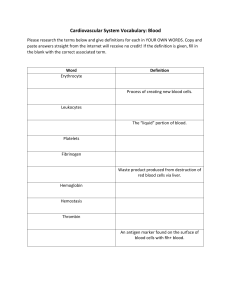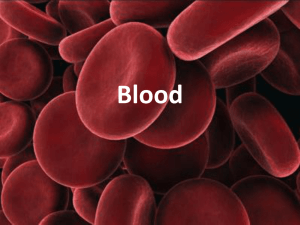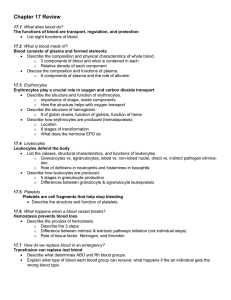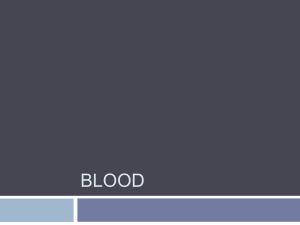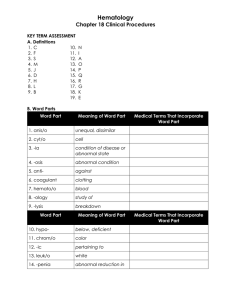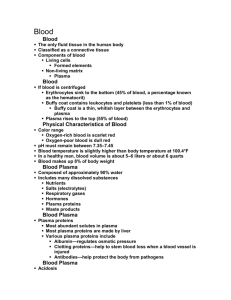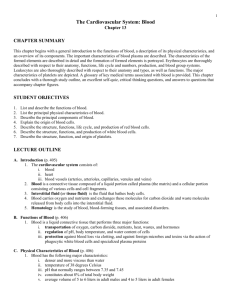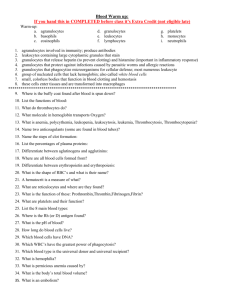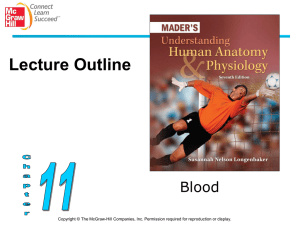Blood Lecture Student Notes
advertisement
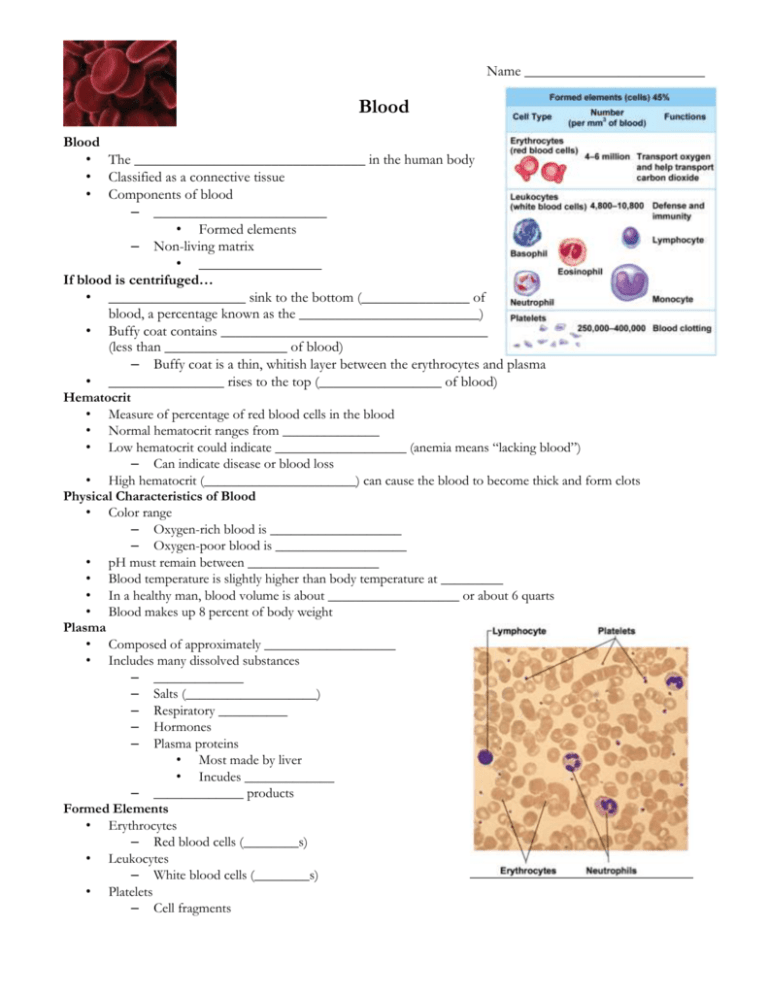
Name _________________________ Blood Blood • The ________________________________ in the human body • Classified as a connective tissue • Components of blood – ________________________ • Formed elements – Non-living matrix • _________________ If blood is centrifuged… • ___________________ sink to the bottom (_______________ of blood, a percentage known as the _________________________) • Buffy coat contains _____________________________________ (less than _________________ of blood) – Buffy coat is a thin, whitish layer between the erythrocytes and plasma • ________________ rises to the top (_________________ of blood) Hematocrit • Measure of percentage of red blood cells in the blood • Normal hematocrit ranges from ______________ • Low hematocrit could indicate ___________________ (anemia means “lacking blood”) – Can indicate disease or blood loss • High hematocrit (______________________) can cause the blood to become thick and form clots Physical Characteristics of Blood • Color range – Oxygen-rich blood is ___________________ – Oxygen-poor blood is ___________________ • pH must remain between ___________________ • Blood temperature is slightly higher than body temperature at _________ • In a healthy man, blood volume is about ___________________ or about 6 quarts • Blood makes up 8 percent of body weight Plasma • Composed of approximately ___________________ • Includes many dissolved substances – _____________ – Salts (___________________) – Respiratory __________ – Hormones – Plasma proteins • Most made by liver • Incudes _____________ – _____________ products Formed Elements • Erythrocytes – Red blood cells (________s) • Leukocytes – White blood cells (________s) • Platelets – Cell fragments Erythrocytes (Red Blood Cells or RBCs) • Main function is to ____________________________ • Anatomy of circulating erythrocytes – Biconcave disks – Essentially bags of ______________________ – Anucleate (_______________________) – Contain very few organelles • ____________________ RBCs per cubic millimeter of blood Hemoglobin • __________-containing protein • ________ strongly, but reversibly, _____________ • Each hemoglobin molecule has four oxygen binding sites • Each erythrocyte has _____________ hemoglobin molecules • Normal blood contains 12–18 g of hemoglobin per 100 mL blood Leukocytes (White Blood Cells or WBCs) • Crucial in the body’s __________________________ • These are complete cells, with a nucleus and organelles • Can move by amoeboid motion • Can respond to chemicals released by damaged tissues • __________________ WBC per cubic millimeter of blood Abnormal Numbers of Leukocytes • Leukocytosis – WBC count above 11,000 leukocytes/mm3 – Generally __________________________ • Leukopenia – Abnormally low leukocyte level – Commonly caused by certain drugs such as corticosteroids and __________________________ • Leukemia – _____________________ becomes cancerous, turns out excess WBC Platelets • Derived from ruptured multinucleate cells (megakaryocytes) • Needed for the __________________________ • Platelet count ranges from _____________________ per cubic millimeter of blood – _____________ is considered a normal number of platelets per cubic millimeter of blood Hematopoiesis • __________________________ • Occurs in red bone marrow • All blood cells are derived from a common stem cell (hemocytoblast) • Hemocytoblast differentiation – Lymphoid stem cell produces lymphocytes – Myeloid stem cell produces all other formed elements Formation of Erythrocytes • Unable to _______________________________________ • Wear out in _____________________ • When worn out, RBCs are eliminated by phagocytes in the _____________________ • Lost cells are replaced by division of hemocytoblasts in the red bone marrow Control of Erythrocyte Production • Rate is controlled by a hormone (____________________) • _____________ produce most erythropoietin as a response to ___________________________________ • Homeostasis is maintained by __________________________ from blood oxygen levels Formation of WBCs and Platelets • Controlled by _____________ – Colony stimulating factors (CSFs) and interleukins prompt bone marrow to generate leukocytes – Thrombopoietin stimulates production of platelets Hemostasis • __________________________ resulting from a break in a blood vessel • Hemostasis involves three phases – Vascular spasms – Platelet plug formation – Coagulation (blood clotting) Hemostasis • Blood usually clots within ____________________ • The clot remains as endothelium regenerates • The clot is broken down after tissue repair Undesirable Clotting • _____________ – A clot in an unbroken blood vessel – Can be deadly in areas like the heart • _____________ – A thrombus that breaks away and floats freely in the bloodstream – Can later clog vessels in critical areas such as the brain Bleeding Disorders • Thrombocytopenia – __________________________ – Even normal movements can cause bleeding from small blood vessels that require platelets for clotting • Hemophilia – Hereditary __________________________ – Normal clotting factors are missing Blood Groups and Blood Transfusions • Large losses of blood have serious consequences – Loss of 15 to 30 percent causes _____________ – Loss of over 30 percent causes _____________, which can be fatal • _____________ are the only way to replace blood quickly • Transfused blood must be of the same blood group Human Blood Groups • Blood contains __________________________ proteins • ______________ (a substance the body recognizes as foreign) may be attacked by the immune system (A and B antigens) • _____________ are the “recognizers” • Blood is “typed” by using antibodies that will cause blood with certain proteins to clump (____________) ABO Blood Groups Blood Group AB B A O RBC Antigens Plasma Antibodies Blood that can be received Rh Blood Groups • Named because of the presence or absence of one of eight Rh antigens (agglutinogen D) that was originally defined in Rhesus monkeys • Most Americans are Rh+ (Rh positive) • Problems can occur in mixing Rh+ blood into a body with Rh– (Rh negative) blood Rh Dangers During Pregnancy • Danger occurs only when the mother is Rh– and the father is Rh+, and the child inherits the Rh+ factor • RhoGAM shot can prevent buildup of anti-Rh+ antibodies in mother’s blood • The mismatch of _________________________________________________________________ can cause problems for the unborn child – The first pregnancy usually proceeds without problems – The immune system is sensitized after the first pregnancy – In a second pregnancy, the mother’s immune system produces antibodies to _____________ _______________ (hemolytic disease of the newborn) Blood Typing • Blood samples are mixed with anti-A and anti-B serum • ____________________________________________________ leads to determining blood type • Typing for ABO and Rh factors is done in the same manner • Cross matching—testing for agglutination of donor RBCs by the recipient’s serum, and vice versa

